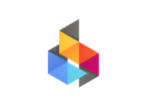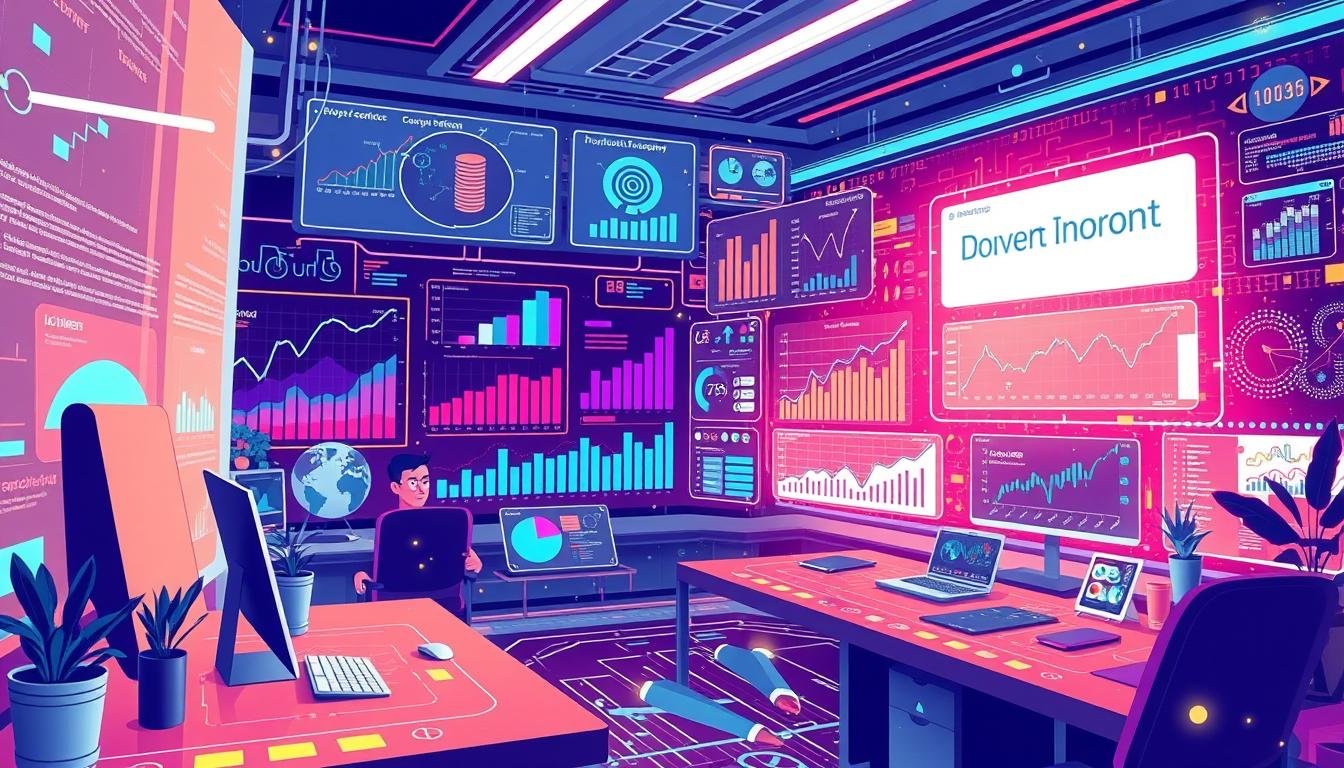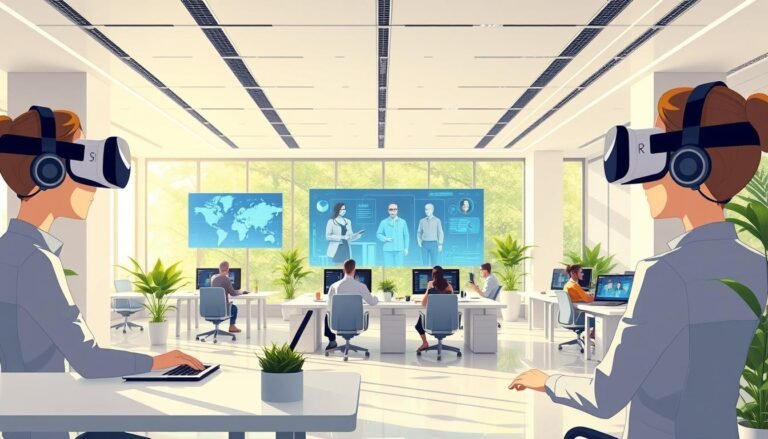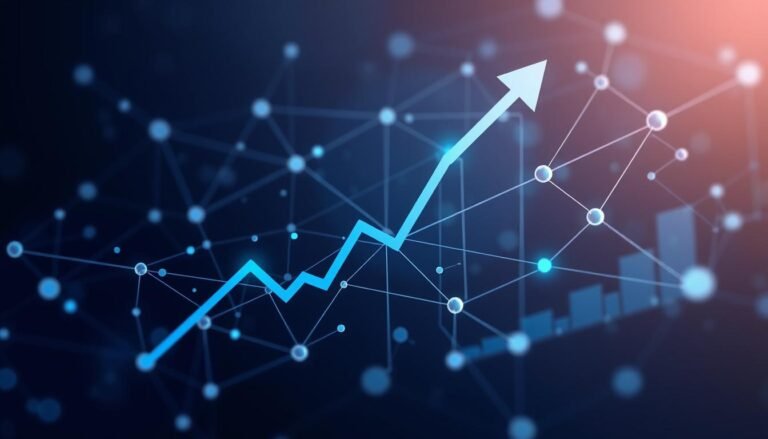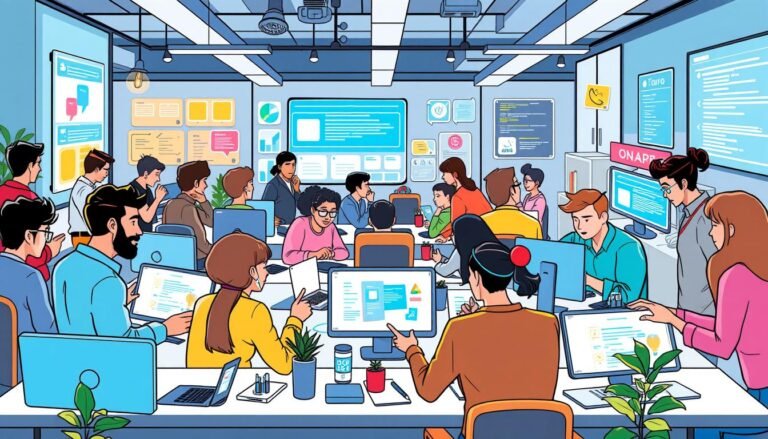HR Analytics and Predictive Modeling
In today’s world, HR Analytics and Predictive Modeling are making a big difference. They help companies make better choices about their employees. With only 17% of organizations using HR data well, there’s a lot of room for improvement.
Predictive HR analytics lets companies predict what employees will do next. It helps spot who might leave and how well they’ll perform. This way, HR teams can plan better and make choices based on facts, not just guesses.
Data-Driven Decision Making in HR is growing fast. The Sapient Insights Group found that 53% of companies use HR tech with built-in analytics. This shows more businesses want to use data to guide their HR choices.
Workforce Planning also gets a boost from these tools. By looking at past data and using smart math, HR can predict future needs. This helps them get ready for future workforce challenges.
Key Takeaways
- Only 17% of organizations use HR data effectively
- 53% of companies have adopted HR tech with analytics
- Predictive analytics help forecast employee behavior and turnover risks
- Data-driven decisions improve HR strategies
- Workforce planning benefits from predictive modeling
- There’s big potential for growth in HR analytics use
Understanding HR Analytics
HR analytics changes how we manage human resources by using data to make decisions. It’s also known as People Analytics. It uses different methods to understand workforce trends and improve how organizations work.
Definition and Importance
HR analytics collects and analyzes data to help make better decisions in human resources. It uses four main types of analytics: descriptive, diagnostic, predictive, and prescriptive. Each type helps us understand and improve how we manage our workforce.
Descriptive analytics looks at past data to understand trends. Diagnostic analytics digs deeper to find out why things happened. Predictive analytics guesses what might happen in the future. Prescriptive analytics gives advice on how to handle future situations.
Key Metrics in HR Analytics
HR Metrics are key to measuring and improving how well an organization works. Some important metrics include:
- Employee turnover rates
- Time-to-hire
- Cost-per-hire
- Employee engagement scores
- Performance indicators
These metrics help cut costs, improve keeping employees, and make hiring better. By focusing on these areas, companies can change HR from just reacting to being proactive. This lets them use data to manage their workforce better.
“Only 29% of HR leaders feel confident that their organization’s current processes are effective at helping employees achieve and sustain their best possible performance.” – Gartner Survey
This statistic shows how important HR analytics is for improving how well an organization works and how employees perform. By using data, companies can make smart choices that help their workforce and profits.
What is Predictive Modeling?
Predictive modeling is a big deal in HR. It uses data to guess what will happen next. This helps companies make better choices about their team.
Basic Concepts
Predictive modeling works by analyzing past data with statistical methods and Machine Learning Models. In HR, it looks at employee data to find patterns. This helps make smart guesses about the future.
For instance, it can predict which employees might leave. This is called Attrition Forecasting. By checking job satisfaction, work history, and performance, it spots who might leave.
Applications in HR
Predictive modeling has many uses in HR:
- Predictive Hiring: Finds candidates who are likely to succeed and stay
- Employee Retention: Identifies who might leave, so you can keep them
- Performance Prediction: Guesses who might become top performers
Big companies are already seeing benefits. Google uses it to guess when salespeople might leave. HP saved $300 million by stopping employee turnover early.
“Predictive analytics can be up to 17 times more accurate than guesswork at predicting the risk of employee turnover.”
Even though it’s powerful, only about 17% of companies worldwide use HR data well. This means a lot of room for companies to use predictive modeling in HR.
The Benefits of Combining HR Analytics and Predictive Modeling
HR analytics and predictive modeling are changing how companies manage their teams. They help find valuable insights and guide HR decisions with data.
Enhanced Decision-Making
When HR analytics and predictive modeling team up, planning the workforce gets better. Companies can predict talent needs, spot skill gaps, and plan for hiring and training. This way, HR can match the workforce with business goals.
Improved Employee Retention
Keeping employees happy is key to keeping them. Predictive modeling spots who might leave by looking at performance, promotions, and surveys. HR can then focus on keeping these employees, saving on turnover costs.
Talent Acquisition Optimization
Using data in HR can make hiring better. By looking at past hires and what made them succeed, companies can pick the right candidates. This leads to smarter hiring and less money spent on finding the right people.
| HR Analytics Benefits | Impact |
|---|---|
| Enhanced Decision-Making | 50% growth in predictive analytics use over 3 years |
| Improved Employee Retention | Up to 50% reduction in turnover for engaged employees |
| Talent Acquisition Optimization | 83% of leaders see hiring as a business-level priority |
Using HR analytics and predictive modeling helps companies build a better team. As the HR analytics market grows, companies that use these tools will stay ahead in managing talent and success.
Key Tools for HR Analytics and Predictive Modeling
The HR Tech Stack has grown to include powerful tools for analytics and data mining. These tools help HR professionals make informed decisions. They also provide valuable insights into the workforce.
Software Solutions
R and Python are top choices for HR analytics software. R is great for big datasets and complex stats. Python is easier to learn and is getting more popular.
For beginners, Microsoft Excel is a favorite. It’s easy to use and has many built-in functions.
Data Visualization Tools
Showing data well is key in HR analytics. Tools like Microsoft Power BI and Tableau are leaders in this area. Power BI works well with Excel. Tableau is known for its easy-to-use interface and stunning graphics.
| Tool | Key Feature | Best For |
|---|---|---|
| R | Advanced statistical analysis | Large datasets |
| Python | Versatile programming | Data science beginners |
| Excel | User-friendly interface | Basic data analysis |
| Power BI | Excel integration | Interactive dashboards |
| Tableau | Superior visualizations | Data storytelling |
Choosing the right tools for your HR Tech Stack depends on your organization’s data maturity and needs. By using these Analytics Platforms, you can unlock your HR data’s full potential. This leads to meaningful insights for your business.
The Role of Data in HR Analytics
Data is key in HR analytics, helping make informed decisions. HR uses different data types to improve processes, increase productivity, and better employee experiences.
Types of Data Used
Employee data is the base for HR analytics. It includes things like demographics, work history, and skills. Performance metrics show how well individuals and teams do their jobs. Survey data helps understand how happy and engaged employees are.
Companies using HR analytics have seen big wins. Google now only needs four interview rounds, keeping an 86% confidence in hiring. Under Armour cut employee leaving by 50% thanks to analytics.
Data Collection Methods
HR teams use many ways to get important data:
- HRIS databases hold all employee records
- Performance management systems track work metrics
- Employee surveys measure engagement and satisfaction
- Recruitment platforms give insights into hiring
- External market data offers industry standards
E.ON, a German electric company, cut down on absences by using HR data. This shows how data can lead to real improvements in managing the workforce.
“HR analytics has been shown to lead to a 25% increase in business productivity.”
While the benefits are clear, keeping data safe and private is crucial. It’s important to be open about privacy policies and have strong security. This helps keep employee trust and follows rules in HR analytics.
Implementing HR Analytics in Your Organization
HR analytics can change how your company makes decisions. It helps you understand your workforce and how employees act. Let’s look at how to start and deal with common problems.
Steps to Get Started
To start with HR analytics, follow these steps:
- Check your current tech setup
- Find and gather important data
- Create models that fit your needs
- Teach your HR team how to analyze
- Work with IT and business leaders
Overcoming Common Challenges
Starting HR analytics isn’t easy. Here are some issues and how to solve them:
| Challenge | Solution |
|---|---|
| Data quality problems | Use data cleaning and validation |
| HR team lacks skills | Invest in training for HR |
| People resist change | Build a data-driven culture with clear messages |
| Worries about data privacy | Follow data protection laws |
By tackling these problems, you can make HR analytics work for your company. Remember, managing change is key. Adopt a data-driven approach, improve your team’s skills, and keep improving for lasting success in HR analytics.
Best Practices for Predictive Modeling in HR
Predictive modeling in HR is a game-changer. It helps companies make smarter decisions about their workforce. Let’s explore some best practices to get the most out of this powerful tool.
Model Selection
Choosing the right model is crucial. Your model should fit the specific HR problem you’re trying to solve. For example, if you’re predicting employee turnover, you might use a different model than if you’re forecasting hiring needs. Remember, simpler models are often better. They’re easier to understand and explain to others.
Testing and Validation
Once you’ve selected a model, it’s time for testing. Split your data into training and testing sets. Use the training set to build your model and the testing set to check its accuracy. This process, known as data validation, helps ensure your model works well on new data.
Keep in mind that model accuracy isn’t everything. A model that’s 100% accurate on your test data might be overfitting. It’s better to have a model that performs well consistently on different datasets.
- Regularly update your model with new data
- Balance complexity with interpretability
- Consider ethical implications, like preventing bias
By following these practices, you can harness the power of statistical analysis to drive better HR decisions. Remember, the goal is to create models that are not just accurate, but also useful and actionable for your HR team.
Case Studies: Successful Implementation
HR Analytics Success Stories and Predictive HR Case Studies show how data changes HR. Let’s look at some amazing examples and what we can learn from them.
Companies Leading the Way
Credit Suisse’s program to track employee turnover is a big win. They used predictive models and saved $70 million a year. Best Buy also saw big gains. A small boost in employee happiness led to over $100,000 more profit per store.
Experian’s model also made a big difference. It cut employee turnover by 2-3%, saving $8 million to $10 million. IBM’s algorithm brought in $300 million over four years and cut turnover by 25% for key roles.
Lessons Learned from Their Experiences
These stories teach us a lot. First, data quality is key. Companies need to gather and use good data. Second, teamwork is important. HR should work with data experts and leaders to make good models. Lastly, always update your models based on what works.
- Focus on data quality and relevance
- Foster cross-functional collaboration
- Continuously refine models based on outcomes
By following these lessons, companies can use HR analytics and predictive models to improve their workforce. This can lead to big changes in how they manage their teams.
The Future of HR Analytics and Predictive Modeling
The world of human resources is changing fast. HR analytics and predictive modeling are leading this change. As we look ahead, using AI in HR is key for companies to stay ahead.
Emerging Trends
Predictive Workforce Planning is becoming more popular. By 2025, 51% of medium-sized companies plan to spend more on HR analytics, says Forbes. This is because HR analytics can make a company 6.3 times more profitable than its competitors.
The HR analytics market is expected to grow by 11%. It will reach $3.6 billion by 2025. This growth shows how important HR analytics is becoming.
The Impact of AI and Machine Learning
AI is changing HR for the better. It makes HR tasks more efficient and accurate. Companies using AI in HR analytics can cut down on administrative tasks by 35% and boost talent productivity by 50%.
In recruitment, AI helps recruiters work 70% faster. It also cuts the time it takes to fill positions in half. These changes are making HR more strategic and less about routine tasks.
The future of HR is all about data, predictions, and AI. Companies using these technologies are making better decisions and creating better work environments. The future of HR is exciting for businesses ready to adapt.
Source Links
- Unlocking the Power of Predictive Analytics in HR: A Comprehensive Guide
- Predictive HR Analytics: Meaning and Real Life Examples – Humaans
- 4 Types of HR Analytics [With Examples]
- What is HR Analytics? Benefits, Types, and Examples
- Predictive HR Analytics: What It Is and How To Use It (2025) | Visier
- Predictive Analytics in Human Resources: Tutorial and 7 case studies
- How HR Can Benefit from Predictive Analytics
- Predictive Analytics in HR: Benefits and Applications
- Predictive Analytics Can Help Companies Manage Talent
- What Is Predictive HR Analytics?
- Top 9 HR Analytics Tools
- A Guide to the 10 Best HR Analytics Tools for HR Professionals
- What is HR Analytics? All You Need to Know to Get Started
- Role of Analytics & Data in Human Resource Management
- Using Predictive Analytics in HR
- Predictive Analytics in HR Examples (Complete Guide) – HR University
- Predictive Analytics for HR: How to Use it – Hirebee
- Predictive Analysis: 5 best practices every HR needs to know
- The power of predictive HR analytics: Shaping your future strategies | peopleHum
- How Predictive Analytics is Revolutionizing HR: 5 Strategies You Can Use Today
- 15 HR Analytics Case Studies with Business Impact
- Case Studies of Successful Implementation
- The Future of HR: How Predictive People Analytics is Revolutionizing Talent Management – Commonwealth Payroll & HR
- The Future of HR Analytics: Emerging Trends and Technologies
